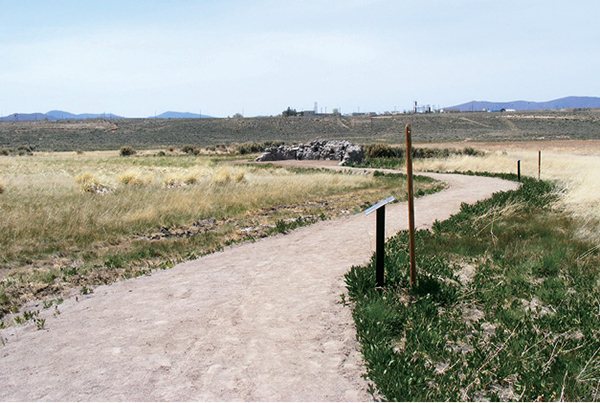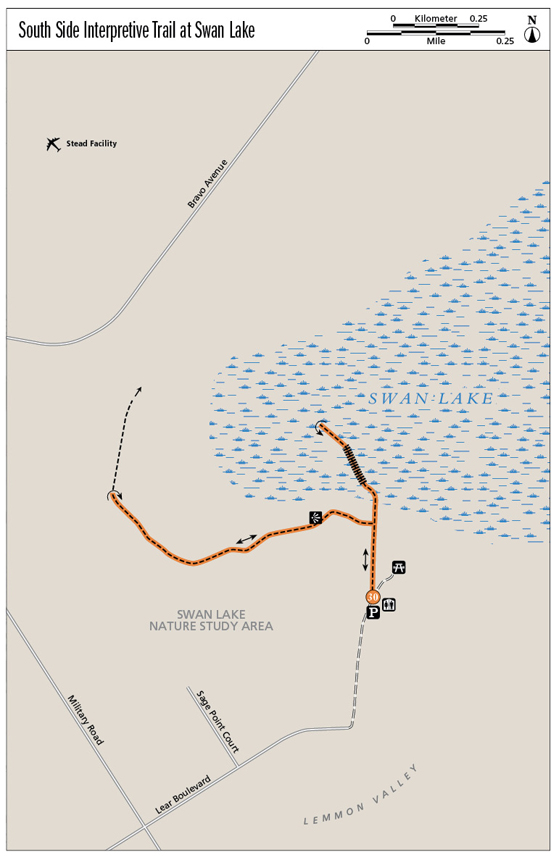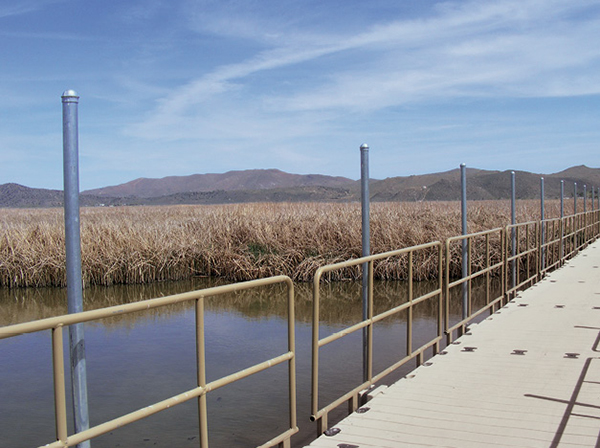
The interpretive trail at Swan Lake leads to a stony hummock of a blind.
30
South Side Interpretive Trail at Swan Lake
A trail and a boardwalk lead through the Swan Lake Nature Study Area, where birds and hikers alike find a watery refuge in the desert.
Start: At the signed trailhead at the end of Lear Boulevard
Distance: 1.4 miles out and back on trail; 0.5 mile out and back on boardwalk (1.9 miles total)
Hiking time: 1.5–2 hours
Difficulty: Easy
Trail surface: Dirt and gravel singletrack; boardwalk
Best seasons: Spring and fall; avoid the unshaded trails on hot summer days
Other trail users: None
Trailhead amenities: Restrooms, a covered picnic shelter, trash receptacles
Canine compatibility: Leashed dogs permitted
Fees and permits: None
Schedule: Park hours are from 8 a.m. to 9 p.m. June to Sept; 8 a.m. to 7 p.m. Sept to Nov; 8 a.m. to 5 p.m. Nov to Mar; and 8 a.m. to 7 p.m. Mar to June
Maps: USGS Reno NV; www.nvtrailmaps.com
Trail contact: Swan Lake Nature Study Area, Washoe County Department of Regional Parks and Open Space, 2601 Plumas St., Reno, NV 89509; (775) 823-6500; www.washoecountyparks.com. Lahontan Audubon Society, PO Box 2304, Reno, NV 89505; (775) 324-BIRD (2473); www.nevadaaudubon.org.
Other: Bring binoculars and a guidebook to help you identify the birds that live near or visit the lake. The boardwalk section of the trail is handicapped accessible.
Finding the trailhead: From the intersection of I-80 and US 395 in downtown Reno, head north on US 395 for 8 miles to the Lemmon Drive exit. Go right (east) on Lemmon Drive for 1 mile to Military Road and turn left (north). Follow Military Road for 1.6 miles to Lear Boulevard. Turn right (east) on Lear Boulevard and go 0.4 mile to the end of the pavement. Head left (north) for 0.2 mile on the dirt road signed for the Swan Lake Nature Study Area to the trailhead and parking area. GPS: N39 39.024' / W119 51.395'
The Hike
The two prongs of this Swan Lake Nature Study Area tour venture into vastly different environments, though that won’t be evident from the trailhead. Especially in dry years you’ll see nothing but high desert scrubland stretching to the north and west, with no hint that Swan Lake exists at all.
The natural area has a distinctly unnatural setting, with warehouses on the south and west and wastewater treatment ponds on the east. The shallow lake and its surrounding wetlands, fed by meltwater from Peavine Peak to the southwest and treated wastewater (no swimming or fishing is permitted), can be as small as 100 acres or as large as 1,000 acres, depending on the amount of rainfall and runoff. Conditions will dictate whether the lake will be visible from the trailhead or trail, but generally the boardwalk passes over water.
The trail to the boardwalk is so easy that flip-flops can serve as appropriate footwear and is perfect for the elderly, those confined to wheelchairs, and small children. Constructed of recycled plastic boards, the floating walkway winds through a cattail-filled marsh to a viewing deck overlooking an expanse of dark water where ducks, geese, coots, swans, stilts, and avocets may be spotted.
The flat, easy South Side Interpretive Trail leads into a typical northern Nevada scrubland, with views of rolling brown hills to the north and east and Peavine Peak rising above the industrial complex to the southwest. Carpeted in bitterbrush, sages, and desert peach, the landscape is habitat for a variety of songbirds—swallows, blackbirds, and wrens—as well as raptors such as burrowing owls, northern harriers, and golden and bald eagles. Walk softly and quail are likely to scurry across the path in front of you, sparrows watch from perches atop the bushes, and garter snakes slither from trail’s edge to the safety of nearby rocks.

The interpretive trail at Swan Lake leads to a stony hummock of a blind.
Begin by following the raised gravel path to an information signboard ringed by benches, where the boardwalk and interpretive trail separate. You can do either or both: The interpretive trail is described first, then the boardwalk.
The interpretive trail leads first to a molded plastic blind in the form of a low rock wall. The mock-rock structure is posted with interpretive plaques and offers birders a chance to identify avian species without disturbing them.
From the blind the singletrack climbs gently into the scrub, with some sections white and alkaline, others sandy, and others paved in gravel. Turn around when you reach the dirt roadway that stretches north and south along the western boundary of the natural area, and return to the junction with the trail to the boardwalk.
As you head out onto the lake, the gravel path leads to a clump of cottonwood and willow, where you’ll cross a bridge onto the recycled plastic boardwalk. Interpretive signs describe everything from how wastewater is used to maintain the marsh to the species of birds, mammals, and amphibians that are either permanent residents of the area or are likely to migrate through. Benches and viewing platforms offer places to rest and observe. The boardwalk ends at a platform overlooking the shallow lake where, depending on the season, a variety of ducks, coots, and other shorebirds play, feed, snort, and rumble on the water.
Enjoy the sights and sounds, then return to the trailhead via the same route.

Miles and Directions
0.0Start by heading north on the gravel path.
0.1The trail splits at the information signboard. Go left (west) on the singletrack South Side Interpretive Trail.
0.2Arrive at the mock-rock blind. Continue west on the obvious singletrack.
0.7Arrive at the dirt roadway; this is the turnaround point.
1.3Return to the trail junction at the information signboard. Turn left (north) to reach the boardwalk.
1.5Arrive at the observation deck at the end of the boardwalk overlooking the lake.
1.9Return to the trailhead and parking area.
Hike Information
Local information: The Chamber, serving Reno, Sparks, and northern Nevada, offers information and links to community events, government, and businesses including restaurants and lodging. The Reno office is at 449 S. Virginia St. 2nd Floor, Reno, NV 89501; (775) 636-9550; www.thechambernv.org. For information about the city of Reno, call Reno Direct at (775) 334-INFO or visit www.reno.gov/index.aspx?page=1.

A floating boardwalk allows hikers and birders to walk among the cattails, which harbor a bounty of birdlife.